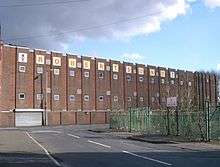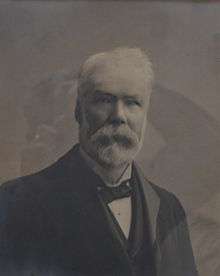Robertson's
 | |
| Product type | Food |
|---|---|
| Owner | Hain Celestial Group |
| Country | United Kingdom |
| Introduced | 1864 |
| Previous owners |
Rank Hovis McDougall Premier Foods |
| Website |
www |


Robertson's is a UK brand of marmalades and fruit preserves that was founded by James Robertson in 1864. The company was run as a partnership until 1903, when it was incorporated as a limited company - James Robertson & Sons, Preserve Manufacturers, Limited. It produces the "Golden Shred" marmalade among other products.
History
James Robertson of Paisley, Renfrewshire, Scotland was born on 16 January 1832 in Niddry Street, Paisley. He started life working in the local thread mills. During a long down turn in the silk trade, Robertson decided to change trades and became apprenticed to a local grocer, hoping this would give him a better future.
On 15 June 1856, he married Marion McFadyen and started up in business as a grocer at 86 Causeyside Street, Paisley. Robertson was a charitable man and one day, taking pity on a salesman, bought a barrel of Seville oranges from him, which are known for their bitter taste. Not wanting to see her husband waste money, Mrs Robertson took to making a sweet tasting marmalade in the back of the shop, which the couple perfected over the following few months. The resultant clear and tangy Golden Shred marmalade became a commercial success. The couple had developed a method to remove the bitterness of the orange, while retaining what Robertson called "the highly tonic value of the fruit". It is asserted that this same process is used in the present day to give Robertson's preserves a distinct flavour.[1] So popular was the product, that in 1864 a separate company was formed to lease a factory on Stevenson Street in the south of the town to meet increased demand. Jam and mincemeat were soon added to the range. In 1891 the company built a factory at Droylsden, Manchester.[1][2]
In 1903, James Robertson & Sons, Preserve Manufacturers, Limited was incorporated to run the business.
In 1914 James Robertson died aged 83. He had featured in the public life of Paisley, having been a member of the council, a magistrate, a school director, and the manager of a savings bank, as well as belonging to a variety of philanthropic societies. His eldest son John succeeded as company chairman, establishing the firm as a leader in the preserves industry. Robertson’s were awarded royal warrants of appointment by King George V in 1933, King George VI and also by the present Queen Elizabeth.[2]
The original factory was based in Paisley is now a housing estate, St. Andrew's Court, with the street itself named Robertson's Gait. In 2007, owner Premier Foods announced the closure of the factories in both Ledbury and Droylsden by the end of the year, with the group's UK jam production all concentrated on Hartley's plant at Histon, Cambridgeshire.[2] The Droylsden factory was demolished in 2010 and only the small building which housed the electricity mains transformer now remains on an otherwise derelict site.
In the 1920s a Robertson's factory was built in Water Lane, Brislington, Bristol. This was expanded and became the largest jam factory in Europe, and was even served by its own branch railway line. The factory was eventually closed in 1981 with manufacturing transferred to Droylsden. The Sales Accounting and Computer Systems team, led by Alex Prosser, remained in Bristol, leasing offices at Bishopsworth, until 1988. (see "Old Photos of Brislington"}[3]).
In December 2008, Premier Foods announced that it would discontinue jam in the UK under the Robertson brand in 2009. This would allow it to focus marketing on Robertson's Golden Shred Marmalade, and its more successful Hartley's jam brand.[2][4]
In 2012, Premier Foods sold its sweet spreads and jellies business to US multi-national Hain Celestial for £200M.[5] For the first time in its 150-year history Golden Shred is no longer a British brand. In 2013 James Robertson and Sons Ltd, first incorporated in 1903 was dissolved. However, in 2015, James Robertson and Sons Ltd was incorporated by James Robertson's great-great-grandson (also James Robertson).
Marketing
Golly branding
Just before World War I, John Robertson (son of James Robertson) was on a tour of the United States. Whilst on a visit to the backwoods he noticed many young children playing with little black rag dolls with white eyes, made from their mothers' discarded black skirts and white blouses. Intrigued by the popularity of the "Golly" (the name being the children's interpretation of doll), he thought it would make an ideal mascot and trade mark for the Robertson's range of products.[6] Accepted by the company, Golly was first shown on Robertson literature in 1910, on items such as labels and price lists.
Collectables series
In the mid-1920s, skilled enameller H. Miller from Birmingham's Jewellery Quarter approached the company with the idea of enamelled "mascots". Miller produced the first design, a Golly golfer in 1928.[2]
Developed as a brooch-based collector series, by the early 1930s the Golly had appeared in little fruit designs, many of which were worn as jewellery because of their high quality. More sporting designs followed, including county cricketers and footballers with footballs in team colours. 1937 saw the Coronation Golly, complete with Union Jack on its chest.
In 1939 the scheme was discontinued as the metal was needed for the war effort, but by 1946 the Golly was back again. The Golly pendant with chain was introduced by popular demand in 1956. In the 1970s, the design of all Gollies changed from the old Golly with "pop eyes" to the present day Golly with eyes looking to the left. The words "Golden Shred" were removed from his waistcoat, his legs straightened and smile broadened. At about the same time a range of 11 footballer and 12 musician Golly figures were produced in plaster, standing about 2.5" high.[7]
The Robertson Golly was not only limited to badges. There were Robertson Golly dolls, ceramic, Golly games for children, even Golly clothing. At the start of the 1980s the hard enamelled badges were replaced with cheaper to produce acrylic badges, but this did not affect their popularity.
When production stopped in 2001, over 20 million Gollies had been sent out.[2]
Sponsorship
In the 1970's, Robertsons sponsored Clare Francis in her entry with her Ohlson 38 yacht Robertson's Golly in the Observer Singlehanded Transatlantic Race, in which she finished thirteenth overall and set a new women's single-handed transatlantic record.[8]
Discontinuation of Golly
Robertson's officially 'retired' Golly in 2002. The company had found that Golly was, on the whole, no longer popular with the children of families, although the scheme was still successful with adult collectors.
Robertson's always insisted that they did not retire the Golly because of the pressure of political correctness in the 1990s, but simply for commercial reasons.[2] The brand director at Robertson's commented:[9]
| “ | We are retiring Golly because we found families with kids no longer necessarily knew about him. We are not bowing to political correctness, but like with any great make we have to move with the times | ” |
World of Roald Dahl
In 2001, the Golly collectables were replaced by seven Roald Dahl-created characters,[2] as illustrated by Quentin Blake. These included the Big Friendly Giant, Matilda, James and the Giant Peach, and Willy Wonka. This collectables scheme ended in 2006.
Paddington Bear
Since 2014, Robertson's started sponsoring the marmalade with Paddington Bear to coincide with the film of the same name, and its sequel.
References
- 1 2 "The Old Jam Factory". WillIam McDonald. Retrieved 5 August 2012.
- 1 2 3 4 5 6 7 8 "Robertsons Jam to disappear". The Daily Telegraph. 7 December 2008. Retrieved 5 August 2012.
- ↑ "James Robertson & son, Brislington, Bristol".
- ↑ "Mark Ritson on Branding: Premier gets out of a jam". Marketing Magazine. Brand Republic. 9 December 2008.
- ↑ "Premier Foods 'in sticky situation' after jam sale to Hain Celestial". foodmanufacture.co.uk. William Reed Business Media. 23 August 2012.
- ↑ Marcus Dunk, Updated: 5 February 2009- "How the golliwog went from innocent children's hero to symbol of bitter controversy" ...in 1910, John Robertson of jam manufacturing family James Robertson & Sons saw some children playing with a golliwog doll and decided it should be the company's mascot. at dailymail.co.uk, accessed 5 April 2018
- ↑ "Robertson's golliwogs". Revealing Histories: Remembering Slavery. Revealing Histories.
- ↑ Lively Lady: What goes around, comes around, again. "Robertson’s G" (the story of the yacht) at livelylady.org, accessed 12 April 2018
- ↑ "Robertson's Golly retires" Eurofood 30 August 2001
External links
- Official website
- Gollycorner, the history of the Robertson's Golly
- "Golliwogg.co.uk" An independent guide to Golliwogs - "Golliwogs & Robertson's Jam"
- photos of Robertson's Golly badges and collectables
- History of a racist symbol from the Guardian